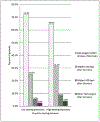Preoperative Medical Testing and Falls in Medicare Beneficiaries Awaiting Cataract Surgery
- PMID: 32926912
- PMCID: PMC8443237
- DOI: 10.1016/j.ophtha.2020.09.013
Preoperative Medical Testing and Falls in Medicare Beneficiaries Awaiting Cataract Surgery
Abstract
Purpose: Delaying cataract surgery is associated with an increased risk of falls, but whether routine preoperative testing delays cataract surgery long enough to cause clinical harm is unknown. We sought to determine whether the use of routine preoperative testing leads to harm in the form of delayed surgery and falls in Medicare beneficiaries awaiting cataract surgery.
Design: Retrospective, observational cohort study using 2006-2014 Medicare claims.
Participants: Medicare beneficiaries 66+ years of age with a Current Procedural Terminology claim for ocular biometry.
Methods: We measured the mean and median number of days between biometry and cataract surgery, calculated the proportion of patients waiting ≥ 30 days or ≥ 90 days for surgery, and determined the odds of sustaining a fall within 90 days of biometry among patients of high-testing physicians (testing performed in ≥ 75% of their patients) compared with patients of low-testing physicians. We also estimated the number of days of delay attributable to high-testing physicians.
Main outcome measures: Incidence of falls occurring between biometry and surgery, odds of falling within 90 days of biometry, and estimated delay associated with physician testing behavior.
Results: Of 248 345 beneficiaries, 16.4% were patients of high-testing physicians. More patients of high-testing physicians waited ≥ 30 days and ≥ 90 days to undergo surgery (31.4% and 8.2% vs. 25.0% and 5.5%, respectively; P < 0.0001 for both). Falls before surgery in patients of high-testing physicians increased by 43% within the 90 days after ocular biometry (1.0% vs. 0.7%; P < 0.0001). The adjusted odds ratio of falling within 90 days of biometry in patients of high-testing physicians versus low-testing physicians was 1.10 (95% confidence interval [CI], 1.03-1.19; P = 0.008). After adjusting for surgical wait time, the odds ratio decreased to 1.07 (95% CI, 1.00-1.15; P = 0.06). The delay associated with having a high-testing physician was approximately 8 days (estimate, 7.97 days; 95% CI, 6.40-9.55 days; P < 0.0001). Other factors associated with delayed surgery included patient race (non-White), Northeast region, ophthalmologist ≤ 40 years of age, and low surgical volume.
Conclusions: Overuse of routine preoperative medical testing by high-testing physicians is associated with delayed surgery and increased falls in cataract patients awaiting surgery.
Keywords: Cataract; Cataract surgery; Delayed surgery; Fall; Fall-related injury; Medicare beneficiaries; Ocular biometry; Physician preoperative testing behavior; Routine preoperative medical testing; Surgical timing.
Copyright © 2020 American Academy of Ophthalmology. Published by Elsevier Inc. All rights reserved.
Conflict of interest statement
Disclosures/Conflicts of Interest:
AWG reports personal fees as a consultant for Masimo Inc and Haisco Pharmaceuticals, unrelated to the submitted work. The other authors have no conflicts of interest to disclose.
Figures



Comment in
-
Preoperative Medical Evaluation for Cataract Surgery: Finally an Opportunity for Common Medical Sense to Prevail.Ophthalmology. 2021 Feb;128(2):216-217. doi: 10.1016/j.ophtha.2020.10.018. Ophthalmology. 2021. PMID: 33485473 No abstract available.
References
-
- Iroku-Malize T & Kirsch S. Eye conditions in older adults: Cataracts. FP Essentials 445, 17–23 (2016). - PubMed
Publication types
MeSH terms
Grants and funding
LinkOut - more resources
Full Text Sources
Other Literature Sources
Medical

